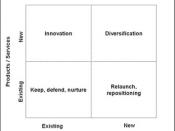1.Introduction
The identification of individuals with similar needs and requirements (homogeneous) will have significant implications for the determination of marketing strategy (Jobber 2001). Marketers can achieve this identification by categorising these individuals into market segments and deciding of which segment(s) to target (Kotler 2003).
Current trends in customer dynamics such as the individual's attitudes, beliefs, intentions, motives, perceptions etc. (CIM study text, 2002) as well as ever-changing environmental factors may influence the variables of which the process of market segmentation is based on. In appendix 1 we can observe the typical bases for segmentation of consumer markets and several indicated customers dynamics.
Moreover specific market research techniques and sources of data can facilitate the endeavours of gathering information, which will allow Buffalo Games to make better, more informed decision (Baines & Chansarkar, 2002).
Also the need of examining consumers' attitudes towards board games and puzzles and how they can be changed or transferred into behaviours (that is to buy our products) has been proved to be important for businesses operating within the sector.
2.Main Body
Demographic segmentation often used as the basis of market segmentation because the data are more easily measurable, quantifiable, accessible and cost effective while revealing trends relevant to marketers, such as shifts in age (CIM study text, 2002). For example according to Mintel's report for toys and games for UK on July 2003, the traditional toys and games sector is being affected by the trend of further falls in the birth rate from already low levels, which will continue to reduce the size of the market available to manufacturers.
On the other hand, socio-economic segmentation is based on variables, which are special demographic characteristics that reflect an individual's social position or economic standing in society (Zikmund & d'Amico, 1999). Although personal disposable income...


